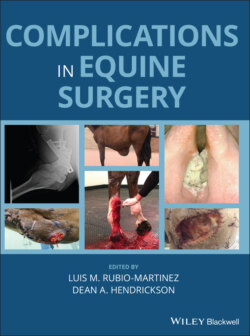Читать книгу Complications in Equine Surgery - Группа авторов - Страница 60
Esophageal/Pharyngeal Trauma
ОглавлениеDefinition
Pharyngeal trauma ranges from mild bruising to perforation of the dorsal pharyngeal wall. Esophageal trauma can include ulcerations, linear lacerations, and partial to full‐thickness perforation of the wall at any point along its length.
Risk factors
Prolonged durations or repeated intubations
Horses that resist intubation by retching and contracting their cervical musculature may be at greater risk for complications
Smaller horse breeds [3]
Pathogenesis
Mild pharyngeal trauma and bruising may occur after nasogastric intubation. Pharyngeal perforation has also been described as a complication of nasogastric intubation [7]. Ulceration or perforation of the esophagus is a documented complication of nasogastric intubation. In one study, the primary cause of esophageal perforations was traumatic nasogastric intubation [8]. In another study, esophageal ulceration or perforation was the predominant complication attributed to nasogastric intubation [3]. Pharyngeal and esophageal trauma can occur with a single intubation; however, prolonged durations or repeated intubations appear to be associated with greater risk of complications [3].
Prevention
It is proposed that pharyngeal and esophageal trauma might be minimized by selecting smaller tube size and sedating horses with an alpha‐2 agonist, such as detomidine, to relax the esophagus [3]. It is important to note that smaller tube size may increase the risk of certain misplacements and sedation may impede the swallowing reflex. The risk of prolonged intubations in horses with persistent gastric reflux needs to be balanced against the risk of repeated, intermittent intubations.
Diagnosis
In most cases, mild pharyngeal trauma and bruising is subclinical and would only be recognized if the horse undergoes endoscopic inspection of the nasopharynx. Endoscopy was necessary to diagnose the pharyngeal trauma after horses developed clinical signs of ptyalism, dysphagia, bruxism, and coughing attributed to pharyngeal trauma [3]. Clinical signs of esophageal trauma have been reported to be indistinguishable from pharyngeal trauma [3]; however, other studies describe the concurrent presence of fever, cervical swelling, and cellulitis when esophageal perforation has occurred [8, 9]. In some perforation cases, the cellulitis and infection may travel caudoventral along the fascial planes towards the mediastinum.
Endoscopy is helpful in identifying esophageal ulcerations and perforations, although small perforations may be hidden within the esophageal folds in some cases [9]. In those situations, ancillary diagnostic tests, such as radiology and ultrasound, may be helpful to support the diagnosis and document the extent of cellulitis.
Treatment
Treatment of pharyngeal trauma and esophageal ulceration is antimicrobial therapy and anti‐inflammatory drugs to manage cellulitis, if present, and feeding of soft feeds or mashes if the horse is dysphagic. Sucralfate may aid in healing of esophageal ulcerations. Tracheostomy may be necessary if pharyngeal or peri‐esophageal swelling causes upper respiratory tract obstruction. Surgical debridement of esophageal perforations is recommended to establish ventral drainage and excise infected tissues. Broad spectrum antibiotic therapy is required because of the significant degree of contamination and extension of infection along fascial planes. Nutritional and fluid support is a major challenge in these cases, because of the esophageal defect and the need for it to heal. The risks and benefits of indwelling nasogastric tubes versus esophagostomy tubes need to be considered in each individual case [9].
Expected outcome
Prognosis for subclinical pharyngeal trauma and bruising is excellent, whereas prognosis for clinically evident pharyngeal trauma is guarded and depends on the ability to manage the cellulitis and avoid associated complications, such as antimicrobial associated colitis and laminitis [3, 7]. Prognosis for survival after esophageal ulceration is good, although stricture may occur with extensive or circumferential ulcerations. Prognosis for esophageal perforations is guarded, because there is often a delay in treatment, resulting in extensive cellulitis and tissue damage subsequent to the leakage of saliva and feed into the periesophageal tissues with subsequent abscessation, mediastinitis, and tissue necrosis [8, 9].
